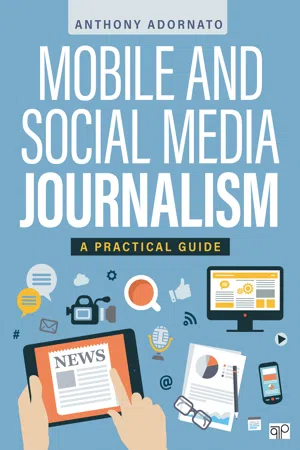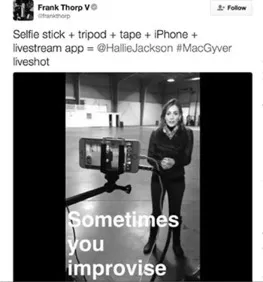When NBC News correspondent Hallie Jackson covered the 2016 US presidential election, the frenetic pace of reporting on the race for the White House went far beyond producing stories for the network’s newscasts.
Armed with a mobile device, Jackson brought her social media followers along for the ride as she spent the better part of a year reporting from the campaign trail.
Between live shots, writing packages, and chasing down politicians, she tweeted (@HallieJackson), created stories on Snapchat (hallienbc), and shared photos on Instagram (hallie_gram). Her social media posts provided the latest campaign news while also giving followers a behind-the-scenes look at her reporting process and some of the more lighthearted moments.
“Mobile and social media are ways to open the reporting process and bring more people into it. It’s a natural part of how I report, because in this day in age I can’t wait for my next live shot to get info out there,” said Jackson.
“The interactions we have with the audience now are so different from when I began in the business in 2006. You’re always continuing the conversation online.”
At one point, Jackson’s producer used a selfie stick, iPhone, duct tape, and a live-streaming app to produce one of her live reports—something that was unheard of just years prior. And yes, that moment was shared on Twitter and Snapchat.
Jackson even did many live shots from inside a moving car as she followed campaign busses from event to event. Those roving live reports that viewers saw on television were also made possible by simply using a mobile phone. No fancy equipment or traditional video cameras involved.
@HallieJackson. Twitter post. May, 2010.
With her mobile device in hand, NBC News correspondent Hallie Jackson is constantly connected to the audience while reporting in the field. While covering the 2016 US presidential race, her producer even used an iPhone and selfie stick for a live shot.
@Frank Thorp V. Twitter Post. March 13, 2016.
Welcome to journalism today. The tools of the trade are now in the palms of our hands. With a single mobile device, journalists produce and share content across different platforms—social media, mobile, websites, and TV.
But it’s not simply about journalists “pushing out” content on multiple platforms.
Journalists are expected to interact with audiences—meet the public in spaces where they’re now spending an increasing amount of time consuming and producing information. Audiences are actively engaged with news on social media platforms and mobile devices, whether by posting photos from the scene of breaking news, tweeting with reporters about their stories, or sharing a news outlet’s story with their circle of social media followers.
These interactions, fueled by new technologies, are reshaping journalists’ relationships with news consumers and how news is produced.
Flashback: What’s the Internet, Anyway?
The year was 1994. NBC News Today show anchors Katie Couric, Bryant Gumbel, and Elizabeth Vargas discuss, with some confusion, this new “thing” called “the Internet.”
Gumbel asks, “What’s Internet anyway?” His coanchors chime in: It’s “that massive computer network that is becoming really big now.”
The anchors are also puzzled over the @ symbol in an e-mail address displayed on the screen. “I wasn’t prepared to translate that . . . that little mark with the a and then the ring around it,” says Gumbel.
“At,” says Vargas.
“See that’s what I said,” responds Gumbel. “Katie said she thought it was ‘about.’”
Years after this entertaining exchange took place, it was posted online and, you guessed it, went viral. I show this video on the first day of class because the clip demonstrates how in a such a short time span the online medium has gone from uncharted territory for journalists to a space where we produce nearly all of our work. Of course, the Internet was the launching point for what came next: the birth of social media.
View the video: bitly.com/InternetFlashback
Technology and Journalism
Before diving into specific mobile and social media skills, strategies, and tools, it’s critical to understand how journalism reached this crossroads. Reflecting on the past provides an important perspective on where the industry stands now and where it may be headed.
From the printing press to computers, technology has always shaped how journalists perform their craft and where the public turns for news. The printing press, which gave rise to newspapers, allowed for mass distribution of news in the written form. At first, the process of transmitting news from the field to print was slow and cumbersome. By the time news reached people, it was days––sometimes weeks––old. The telegraph sped up the process, allowing reporters to transmit stories so people could learn of news the day it happened.
Radio and television brought more immediacy to journalism, a new way of telling stories. Journalists were now able to bring audiences to the scene of news through the use of audio, video, and live reports.
The Internet opened up an entirely uncharted world for journalism and audiences. In the late 1990s, most news outlets’ websites were simply a single static page. Print reporters were still focused on the newspaper and broadcast reporters on their stories for TV or radio newscasts. As the audience increasingly turned online for information, news outlets’ websites became more robust, and with that came new tasks for journalists.
Journalists’ responsibilities went far beyond stories for print or TV—producing multimedia web stories with a mix of photos, video, and audio became the norm. You can see that each new technology has affected how and where people get their news as well as how journalists do their jobs.
Fast-forward to the present day. Social media and mobile devices are the latest technologies shaping the field, and they have reached this position in a relatively short amount of time, considering the first iPhone was released in 2007 and Twitter was launched in 2006. Never before in such a short amount of time has a new technology had such a dramatic impact on so many facets of communications.
Before Social Media: One-Way Communication
The reason behind this has to do with fundamental differences between today’s technologies and those in use prior to the introduction of social media, such as the printing press and television. Traditional print and broadcast journalism are based on the mass communications model of one-way communication.
The characteristics of traditional mass communications are these:
- From one entity, person, or group to a large audience
- One-way communication
- Passive audience
Producers of information, such as journalists, told the public what they needed to know with little or no interaction with the audience, in a one-way flow of information. It’s the equivalent of someone talking at you, albeit with interesting and important information, but you’re not allowed or able to respond. A single voice speaks to many. That’s not much of a conversation.
There’s a concentration of power in this model. News consumers were considered passive, because previous technologies didn’t foster immediate engagement with content and journalists. Consumers received the news but had little interaction with it. Writing a letter to the editor or calling a newsroom tips line were the extent of the feedback.
This model—what I call the “voice of God”—has been turned upside down with the emergence of mobile devices and social media now that nearly anyone can produce and share content. The audience has shifted from a passive one to an active one.
After Social Media: Journalism as a Conversation
The audience is at the center of social media. They’re in the driver’s seat. Jay Rosen (@jayrosen_nyu), author and journalism professor at New York University, describes the current audience as passengers on your ship who have a boat of their own.1 They can connect with each other and with journalists, and they have the means to speak to the world.
Therefore, mobile devices and social media are characterized by
- Accessibility: Nearly anyone has access to these tools.
- Active audience: The audience can create and publish content.
- Interactivity: Messages and feedback happen simultaneously.
These characteristics challenge the traditional notion of mass communications. Because of broad access to mobile devices and social media, creating and publishing content has been opened up to the masses. This is in direct contrast to the closed model of traditional media.
The audience can turn to Twitter to complain about a product. They can snap images of a protest and instantly share them on Instagram. They can use Facebook to generate buzz about an event. The list of things this now-active audience can do is endless.
In addition, interactivity fosters a two-way conversation. When someone tweets at a company or journalist, for example, there’s the expectation that the person on the other end will respond almost instantaneously. Just like a conversation.
What does this mean for journalism? Journalism has shifted from a one-way to a two-way conversation that is redefining how journalists report and interact with the audience. Think of journalism as a conversation, rather than a lecture. News outlets can’t ignore audiences active on mobile devices and social media. Journalism as a conversation is a shared action with shifting journalist–audience relationships.
Journalism as a conversation fosters interactivity between the audience and journalists, an informal tone, and an openness on the part of the journalist to audience feedback. As we’ll discuss later in the chapter, this engagement can build trust with the audience. Mobile devices and social media allow journalists to strengthen their connections with the public and ultimately better serve them.
As was the case with NBC News correspondent Hallie Jackson, journalists are expected to not simply wait to share information on the traditional newscasts, in a newspaper, or in an online story. That’s an old way of thinking. As the story unfolds in the field, journalists must turn to social media to share the latest, track online conversations about the story, and respond to people who reach out to them.
Those are just a few of the evolving responsibilities addressed in this book. The skills you will need in today’s newsrooms go well beyond one, or even two, platforms.
Let’s take a deeper look at how mobile devices and social media are impacting the audience and journalists. We start with the audience, because their changing role and habits directly affect how journalists do their jobs.
Changing Role of the Audience
January 2009. A US Airways plane makes an emergency landing in New York City’s Hudson River. Janis Krums, commuting home on a nearby ferry, snaps a photo of passengers huddled on a wing of the plane.
Krums (@jkrums) tweets out one of the first images of what became known as the Miracle on the Hudson. “There’s a plane in the Hudson. I’m on the ferry going to pick up the people. Crazy,” wrote Krums in a tweet heard around the world.
Miracle on the Hudson: Janis Krums tweeted out this photo in 2009 after a US Airways plane made an emergency landing in the Hudson River. Within minutes of Krums sharing this image, news outlets around the world were using it as part of their coverage.
Janis Krums. Twitter Post. January 15, 2009.
Krums had shared his dramatic photo before any journalist could get to the breaking news scene. Within a half hour, the tweet spread like wildfire well beyond his 170 Twitter followers. News outlets around the world were showing the image, and Krums was being interviewed live on TV news networks.
“This may be among the most striking instances yet of instant citizen reporting,” wrote the Los Angeles Times the day of the emergency landing.2
Indeed, the Miracle on the Hudson was a turning point, an eye-opening moment that showed the impact of social media on journalism. It was one of the first instances in which journalists realized the power of the audience in a mobile and social media world.
Twitter, Facebook, and other social networking sites are more than just ways for people to keep in touch with friends and family. They’re platforms for news. Platforms where everyday cit...



